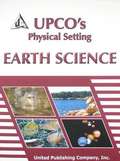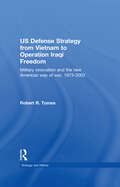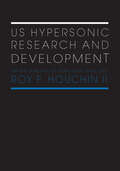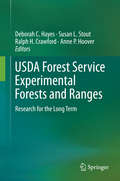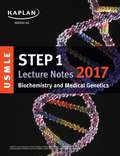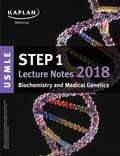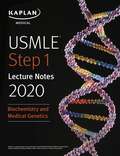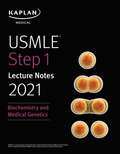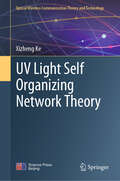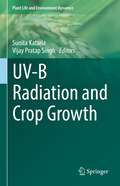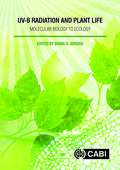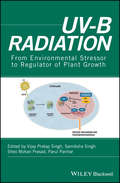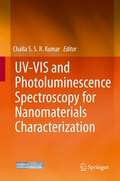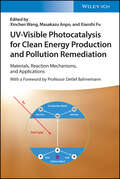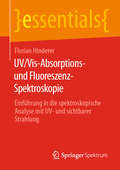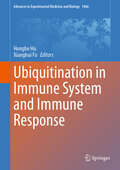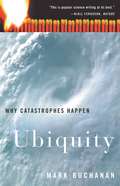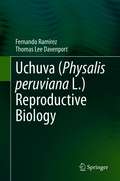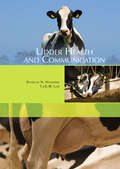- Table View
- List View
UPCO's Physical Setting Review: Earth Science (Revised Edition)
by Robert SigdaWhen you look at the stars or feel the force of the wind, you are making observations. An observation is an interaction of one or more of the senses-sight, hearing, touch, taste, or smell-with the environment or surroundings. The ability of the senses are limited. Therefore, instruments have been invented and developed to extend the powers of observation. Instruments improve our ability to observe and to make measurements that would otherwise be very inaccurate or even impossible to make. For example, a telescope allows us to take a closer look at the stras. A scale enables us to accurately determine how much we weigh by measuring the pull of Earth's gravity on our bodies, which is something our senses don't readily observe.
US Defence Strategy from Vietnam to Operation Iraqi Freedom: Military Innovation and the New American War of War, 1973-2003 (Strategy and History)
by Robert R. TomesUS Defence Strategy from Vietnam to Operation Iraqi Freedom examines the thirty-year transformation in American military thought and defence strategy that spanned from 1973 through 2003. During these three decades, new technology and operational practices helped form what observers dubbed a 'Revolution in Military Affairs' in the 1990s and a 'New American Way of War' in the 2000s. Robert R. Tomes tells for the first time the story of how innovative approaches to solving battlefield challenges gave rise to non-nuclear strategic strike, the quest to apply information technology to offset Soviet military advantages, and the rise of 'decisive operations' in American military strategy. He details an innovation process that began in the shadow of Vietnam, matured in the 1980s as Pentagon planners sought an integrated nuclear-conventional deterrent, and culminated with battles fought during blinding sandstorms on the road to Baghdad in 2003. An important contribution to military innovation studies, the book also presents an innovation framework applicable to current defence transformation efforts. This book will be of much interest to students of strategic studies, US defence policy and US politics in general.
US Hypersonic Research and Development: The Rise and Fall of 'Dyna-Soar', 1944-1963 (Space Power and Politics)
by Roy F. Houchin IIAn essential new account of some of the most valuable research and development in international military history. Roy F. Houchin II shows how the roots of US Air Force hypersonic research and development are grounded in Army Air Force General Henry H. 'Hap' Arnold's identification of the need for advanced airpower weapon systems to meet the anticipated postwar enemy threat. The technology for a smooth transition to military spaceflight seemed within reach when Bell Aircraft Corporation executive Walter Dornberger (the former commander of Nazi Germany's V-2 rocket research) made an unsolicited proposal to William E. Lamar (the chief of Wright Aeronautical Development Center's New Development Office of the Bomber Aircraft Division at Wright-Patterson AFB, OH) for a hypersonic boost-glide weapon system. Visionaries like Arnold, Dornberger, and Lamar believed a hypersonic boost-glider would represent the ultimate expression of the US Air Force's doctrine by performing strategic bombardment and reconnaissance more successfully any other type of vehicle. As this aspiration reached maturity in Dyna-Soar, the service's leadership never gave up their beliefs. This book shows how the struggle to persuade the secretary of defence and his advisors, who did not share the Air Force's vision for a military spaceplane, illustrates the ebb and flow of an advanced technology program and its powerful legacy within American society.
US-Indian Strategic Cooperation into the 21st Century: More than Words (Asian Security Studies)
by Sumit Ganguly Andrew Scobell Brian ShoupIn this edited book, leading scholars and analysts trace the origins, evolution and the current state of Indo-US strategic cooperation. During the Cold War, owing to opposing grand strategies, the two states frequently found themselves at odds. With the end of the Cold War and the demise of the Soviet Union, Indo-US security cooperation started in a fitful fashion, but in recent years it has acquired considerable stability. The armed forces of the two states have participated in exercises on land, sea and air and have also carried out joint humanitarian missions. Drawing on new information and with contributions from both academics and policy makers, this wide-ranging volume analyzes the strategic convergence of the world’s two largest democracies, whilst explaining why important differences do remain. These notably include questions pertaining to the future of India’s nuclear and ballistic missile programs, US-Pakistan ties and India’s links with Iran. This volume will be of great interest to students of South Asian politics, Asian security, US foreign policy and security studies in general.
USDA Forest Service Experimental Forests and Ranges
by Deborah C. Hayes Susan L. Stout Ralph H. Crawford Anne P. HooverUSDA Forest Service Experimental Forests and Ranges (EFRs) are scientific treasures, providing secure, protected research sites where complex and diverse ecological processes are studied over the long term. This book offers several examples of the dynamic interactions among questions of public concern or policy, EFR research, and natural resource management practices and policies. Often, trends observed - or expected -- in the early years of a research program are contradicted or confounded as the research record extends over decades. The EFRs are among the few areas in the US where such long-term research has been carried out by teams of scientists. Changes in society's needs and values can also redirect research programs. Each chapter of this book reflects the interplay between the ecological results that emerge from a long-term research project and the social forces that influence questions asked and resources invested in ecological research. While these stories include summaries and syntheses of traditional research results, they offer a distinctly new perspective, a larger and more complete picture than that provided by a more typical 5-year study. They also provide examples of long-term research on EFRs that have provided answers for questions not even imagined at the time the study was installed.
USMLE Step 1 Lecture Notes 2017: Biochemistry and Medical Genetics
by Kaplan MedicalThe only official Kaplan Lecture Notes for USMLE Step 1 cover the comprehensive information you need to ace the exam and match into the residency of your choice. * Up-to-date: Updated annually by Kaplan’s all-star faculty * Integrated: Packed with clinical correlations and bridges between disciplines * Learner-efficient: Organized in outline format with high-yield summary boxes * Trusted: Used by thousands of students each year to succeed on USMLE Step 1
USMLE Step 1 Lecture Notes 2018: Biochemistry and Medical Genetics
by Kaplan MedicalKaplan Medical's USMLE Step 1 Lecture Notes 2018: Biochemistry and Medical Genetics offers in-depth review with a focus on high-yield topics – a comprehensive approach that will help you deepen your understanding while focusing your efforts where they'll count the most.Used by thousands of medical students each year to succeed on USMLE Step 1, Kaplan's official lecture notes are packed with full-color diagrams and clear review.The Best ReviewOrganized in outline format with high-yield summary boxes for efficient study.Clinical correlations and bridges between disciplines highlighted throughout.Full-color diagrams and charts for better comprehension and retention.Updated annually by Kaplan's all-star expert facultyLooking for more prep? Our USMLE Step 1 Lecture Notes 2018: 7-Book Set has this book, plus the rest of the 7-book series.
USMLE Step 1 Lecture Notes 2019: Biochemistry and Medical Genetics (Kaplan Test Prep)
by Kaplan MedicalThe only official Kaplan Lecture Notes for USMLE Step 1 cover the comprehensive information you need to ace the exam and match into the residency of your choice.Up-to-date: Updated annually by Kaplan’s all-star facultyIntegrated: Packed with clinical correlations and bridges between disciplinesLearner-efficient: Organized in outline format with high-yield summary boxesTrusted: Used by thousands of students each year to succeed on USMLE Step 1Looking for more prep? Our USMLE Step 1 Lecture Notes 2019: 7-Book Set has this book, plus the rest of the 7-book series.
USMLE Step 1 Lecture Notes 2020: Biochemistry and Medical Genetics (Kaplan Test Prep)
by Kaplan MedicalThe only official Kaplan Lecture Notes for USMLE Step 1 cover the comprehensive information you need to ace the exam and match into the residency of your choice. * Up-to-date: Updated annually by Kaplan&’s all-star faculty * Integrated: Packed with clinical correlations and bridges between disciplines * Learner-efficient: Organized in outline format with high-yield summary boxes * Trusted: Used by thousands of students each year to succeed on USMLE Step 1 Looking for more prep? Our USMLE Step 1 Lecture Notes 2018: 7-Book Set has this book, plus the rest of the 7-book series.
USMLE Step 1 Lecture Notes 2021: Biochemistry and Medical Genetics (USMLE Prep)
by Kaplan MedicalThe only official Kaplan Lecture Notes for USMLE Step 1 cover the comprehensive information you need to ace the exam and match into the residency of your choice. * Up-to-date: Updated annually by Kaplan&’s all-star faculty * Integrated: Packed with clinical correlations and bridges between disciplines * Learner-efficient: Organized in outline format with high-yield summary boxes * Trusted: Used by thousands of students each year to succeed on USMLE Step 1 Looking for more prep? Our USMLE Step 1 Lecture Notes 2018: 7-Book Set has this book, plus the rest of the 7-book series.
UV Light Self Organizing Network Theory (Optical Wireless Communication Theory and Technology)
by Xizheng KeThis book covers the basic concepts of UV communication, the analysis of UV channel characteristics, the organize media access protocols, and routing protocols, etc. in the network. Based on the analysis of classical communication protocols, a basic framework for UV self-organising networks is proposed. The communication protocol proposed in the book is analyzed in detail, and the key procedures of computer simulation are given at the end of the book so that readers can learn and understand.This book can guide senior undergraduate and postgraduate students of communications, networking, and other related majors in colleges and universities. It can also be used as a reference book for researchers and engineering technicians.
UV-B Radiation and Crop Growth (Plant Life and Environment Dynamics)
by Vijay Pratap Singh Sunita KatariaThis book is an inclusive collection of topics on research on UVB for its impact on plants with a focus on its use as an emerging technology for crop growth and protection. This book covers role of UV-B on biological systems, and its transformation from generic stressor to specific regulator. It also explores the past research in UVB studies and the changing mind-sets regarding UV-B in recent time with respect to the plant growth. It also explores the discovery of specific UV-B photoreceptor, UVR8 and UVR8 mediated plants responses. This book is of interest to teachers, researchers, agriculture scientists and plant physiologists. Also the book serves as additional reading material for undergraduate and graduate students of agriculture, forestry, ecology, soil science, and environmental sciences
UV-B Radiation and Plant Life
by Brian R. JordanUltraviolet-B radiation (UV-B) has profound effects on plant growth and development, and exposure varies with ozone depletion and across geographic regions, with ecosystem and agricultural consequences. This book deals with large-scale impacts but also how UV-B affects plants at the molecular level is also fascinating, and the UV-B photoreceptor has only recently been characterised. While UV-B radiation can be damaging, it also has a more positive role in plant photomorphogenesis. Consequently UV-B treatments are being developed as innovative approaches to improve horticulture. This book is a timely synthesis of what we know and need to know about UV-B radiation and plants.
UV-B Radiation: From Environmental Stressor to Regulator of Plant Growth
by Parul Parihar Samiksha Singh Sheo Mohan Prasad Vijay Pratap SinghUltraviolet B (UV-B) is electromagnetic radiation coming from the sun, with a medium wave which is mostly absorbed by the ozone layer. The biological effects of UV-B are greater than simple heating effects, and many practical applications of UV-B radiation derive from its interactions with organic molecules.Considered particularly harmful to the environment and living things, what have scientific studies actually shown? UV-B Radiation: From Environmental Stressor to Regulator of Plant Growth presents a comprehensive overview of the origins, current state, and future horizons of scientific research on Ultraviolet B radiation and its perception in plants. Chapters explore all facets of UV-B research, including the basics of how UV-B’s shorter wavelength radiation from the sun reaches the Earth’s surface, along with its impact on the environment’s biotic components and on human biological systems. Chapters also address the dramatic shift in UV-B research in recent years reflecting emerging technologies; showing how historic research which focused exclusively on the harmful environmental effects of UV-B radiation has now given way to studies on potential benefits to humans. Topics include:• UV-B and its climatology• UV-B and terrestrial ecosystems• Plant responses to UV-B stress• UB- B avoidance mechanisms• UV-B and production of secondary metabolites • Discovery of UVR8 Timely and important, UV-B Radiation: From Environmental Stressor to Regulator of Plant Growth is an invaluable resource for environmentalists, researchers and students, into the state-of-the-art research being done on exposure to UV-B radiation.
UV-VIS and Photoluminescence Spectroscopy for Nanomaterials Characterization
by Challa S.S.R. KumarSecond volume of a 40-volume series on nanoscience and nanotechnology, edited by the renowned scientist Challa S.S.R. Kumar. This handbook gives a comprehensive overview about UV-visible and photoluminescence spectroscopy for the characterization of nanomaterials. Modern applications and state-of-the-art techniques are covered and make this volume essential reading for research scientists in academia and industry in the related fields.
UV-Visible Photocatalysis for Clean Energy Production and Pollution Remediation: Materials, Reaction Mechanisms, and Applications
by Masakazu Anpo Xianzhi Fu Xinchen WangUV-Visible Photocatalysis for Clean Energy Production and Pollution Remediation Comprehensive resource detailing fundamentals of photocatalysis, clean energy production, and pollution treatment, as well as recent developments in each field UV-Visible Photocatalysis for Clean Energy Production and Pollution Remediation: Materials, Reaction Mechanisms, and Applications provides current developments in photocatalytic reactions for both inorganic and organic-based materials which operate under UV-visible light or sunlight irradiation, with a focus on the fundamentals and applications in clean energy production and pollution remediation. The text curates interesting and important research surrounding photocatalysis for hydrogen production, including the fundamentals and photocatalytic remediation of our better environments, which covers the reduction of CO2 and fixation of N2 with H2O under UV-visible light or sunlight irradiation. The first chapter of the book introduces these diverse subjects by including a brief history of the developments of photocatalysis research since around the 1960s. Specific sample topics covered in this book include: Visible-light active photocatalysts in pollutant degradation and conversion with simultaneous hydrogen production Application of S-scheme heterojunction photocatalyst and the role of the defects on the photocatalytic reactions on ZnO Strategies for promoting overall water splitting with particulate photocatalysts via single-step visible-light photoexcitation Polymeric carbon nitride-based materials in aqueous suspensions for water photo-splitting and photo-reforming of biomass aqueous solutions to generate H2 Visible light-responsive TiO2 thin film photocatalysts for the separate evolution of H2 and O2 from water For chemists, scientists, physicists, and engineers across a wide range of disciplines, UV-Visible Photocatalysis for Clean Energy Production and Pollution Remediation is an essential resource for understanding current developments in photocatalytic reactions on both inorganic and organic-based materials which operate under UV-visible light or sunlight irradiation.
UV/Vis-Absorptions- und Fluoreszenz-Spektroskopie: Einführung in die spektroskopische Analyse mit UV- und sichtbarer Strahlung (essentials)
by Florian HindererFlorian Hinderer bietet in diesem essential eine leicht verständliche Einführung in Methoden der optischen Spektroskopie. Kurz und präzise, strukturiert und gut zu lesen vermittelt er die Grundlagen der UV/Vis-Absorptions- und Fluoreszenz-Spektroskopie. Vom Grundprinzip und den typischen Anwendungsgebieten der UV/Vis-Absorptions-Spektroskopie führt der Autor zu einem detaillierten Verständnis dieser Methode. Er gibt dafür einen Überblick über Grundlagen zu Auswahlregeln und zeigt die typischen Spektren organischer und anorganischer Moleküle. Ein Kapitel zu den Konzepten der Fluoreszenz-Spektroskopie sowie weiterführende Literatur runden das essential ab.
Ubiquitin Chains: Degradation and Beyond
by Arnab DeThis thesis examines the evidence for regulatory ubiquitination by focusing on A20. It provides an insightful and in-depth evaluation of the current literature by critically examining the evidence of K63-linked regulatory ubiquitination in regulating cell-signalling. It is also the first thesis to directly test the role of regulatory ubiquitination in NF-kB signaling in vivo. The case for regulatory ubiquitination has been to a large extent predicated upon the presumed deubiquitinase activity of A20, long considered a key regulator of inflammatory responses as mice lacking A20 die from multi-organ inflammation and cachexia. The theses reports the creation and characterization of a knock-in mouse that expresses a mutated form of A20 which selectively lacks the deubiquitinase activity. The knock-in mice surprisingly display completely normal NF-κB activation with no accompanying inflammatory phenotype. Given that the presumed role of A20 as a deubiquitinase has been used to support the importance of regulatory K63-linked ubiquitination in NF-kB signaling, this study will help focus future research efforts into alternative target pathways that do not depend on K63 ubiquitination. In fact, the work suggests that it might be important to revisit the role of K63-linked polyubiquitination in cell-signalling. Ubiquitin Chains: Degradation and Beyond is essential reading for anyone conducting research in cell-signalling and immunology. Dr. Arnab De received his PhD from the Department of Microbiology & Immunology at Columbia University. During his PhD, he developed transgenic mice to study the mechanism of action of a critical tumor-suppressor called A20. He is also well known for having developed peptide-based prodrugs as therapeutics for diabetes. His work has been reported by the media, and has resulted in multiple patents and publications in peer reviewed journals. He presented his findings at the American Peptide Symposium and was awarded the Young Investigator's Award. He is the author of the book entitled Application of Peptide-Based Prodrug Chemistry in Drug Development, with a foreword written by Professor Jean Martinez (Former President, European Peptide Society) and published in the series SpringerBriefs in Pharmaceutical Science & Drug Development. His research interests lie at the intersection of chemistry and medicine. Besides biomedical research, he is also generally interested in public health policy and general scientific outreach.
Ubiquitin Family Modifiers and the Proteasome
by Martin Scheffner R. Jürgen DohmenThe ubiquitin-proteasome system (UPS) and ubiquitin-related modifiers are not only involved in cellular protein quality control but also in the regulation of many fundamental cellular processes/pathways as well as in their disease-relevant aberrations. Ubiquitin Family Modifiers and Proteasome: Reviews and Protocols presents both novel developments in UPS research and important methods related to the main recent advances in the field of ubiquitin family modifiers. Divided into five convenient sections, this volume focuses on the enzymology and substrate identification of ubiquitin family modifiers, the recognition and chain formation of these modifiers, the analysis of proteasome biogenesis and function, protein quality control, and finally the use of small molecules and strategies to study or manipulate the function of the UPS and of ubiquitin family modifiers, respectively. Written in the highly successful Methods in Molecular BiologyTM series format, chapters include introductions to their respective topics, lists of the necessary materials and reagents, step-by-step, readily reproducible protocols, and notes on troubleshooting and avoiding known pitfalls. Authoritative and easily accessible, Ubiquitin Family Modifiers and Proteasome: Reviews and Protocols will be of great use to investigators and students engaged in both basic and applied research in life sciences.
Ubiquitin-Proteasome Protocols
by Cam Patterson Douglas M. CyrA collection of cutting-edge techniques for studying ubiquitin-dependent protein degradation via the proteasome. The topics covered range broadly from basic biochemistry to cellular assays to discovery techniques using mass spectrometric analysis. These biochemical and cellular methods are necessary to explore the ubiquitin-proteasome system and ubiquitin-proteasome-dependent functions. State-of-the-art and user-friendly, Ubiquitin-Proteasome Protocols offers novice and experienced bench scientists alike a thorough compendium of readily reproducible techniques that will accelerate discovery, enhance productivity, and permit manipulation of the system for varied research purposes.
Ubiquitination in Immune System and Immune Response (Advances in Experimental Medicine and Biology #1466)
by Hongbo Hu Xianghui FuUbiquitination is a major protein post-translational modification, which is involved in many aspects of cellular procedure. The functions of ubiquitination in immune system and immune response have been intensively studied. This book aims to introduce the latest and crucial achievements, along with the fundamental principles of ubiquitination and immune responses. It covers the proteomic aspects of ubiquitination, the function of ubiquitin in innate and adoptive immunity, the development of immune cells, and the metabolism. The active researchers in this field are invited to contribute the chapters. This book is suitable for graduate students, researchers and readers who are interested in this field. It will provide readers with comprehensive insight into how ubiquitination functions in different aspects of immune system.
Ubiquity: Why Catastrophes Happen
by Mark BuchananScientists have recently discovered a new law of nature. Its footprints are virtually everywhere - in the spread of forest fires, mass extinctions, traffic jams, earthquakes, stock-market fluctuations, the rise and fall of nations, and even trends in fashion, music and art. Wherever we look, the world is modelled on a simple template: like a steep pile of sand, it is poised on the brink of instability, with avalanches - in events, ideas or whatever - following a universal pattern of change. This remarkable discovery heralds what Mark Buchanan calls the new science of 'ubiquity', a science whose secret lies in the stuff of the everyday world. Combining literary flair with scientific rigour, this book documents the coming revolution by telling the story of the researchers' exploration of the law, their ingenious work and unexpected insights. Mark Buchanan reveals how the principle of ubiquity will help us to manage, control and predict the future. This book, the world's first on the topic, will change how we think about the world and our place in it.
Uchuva (Physalis peruviana L.) Reproductive Biology
by Fernando Ramírez Thomas Lee DavenportThis work reviews and explores various aspects of uchuva growth and development from seed germination, vegetative growth and phyllotaxy, floral development, pollination, and pollen morphology through fruit development, properties and health benefits. Other sections of the book cover uchuva genetic diversity, hybridization, chromosome number and morphological diversity. Uchuva is economically important in most South American counties, has been growing in popularity in Central America, and is marketed in North American and Europe as the golden berry. This is the first concise reference work that delves into the fascinating world of uchuva reproductive biology. It includes the latest scientific references, some of which have been contributed by the authors of the current book. The authors have observed the plant in the field and have produced a unique photographic record to help the reader see the actual morphological structures and developmental processes in action.
Udder Health and Communication
by H. Hogeveen T.J.G.M. LamIn dairy industries throughout the world there is a desire to optimize udder health. An improved udder health will lead to improved animal welfare, improved production efficiency and a reduction of the use of antibiotics. To improve udder health, first of all, technical knowledge on issues such as treatment, milking, infectious pressure and host resistance is important. However, over the years we learned that knowledge alone is not enough: knowledge has to be used. And for knowledge to be used, farmers have to be motivated. This requires knowledge about motivation and communication. In this book, recent knowledge on technical udder health issues is combined with knowledge on motivation and communication. A large number of descriptions of mastitis control programs that are being carried out worldwide is combined with more specific studies. These are aimed at effective advising, motivation and communication strategies, economics, and technical studies on mastitis control and prevention. Therefore, this book provides an applied source of information for all that are willing to improve udder health.
Ufology: A Very Short Introduction
by Mark DorioUfology: Presents a serious survey of the study of UFOs and related phenomena, providing a good first step toward understanding this topic.
